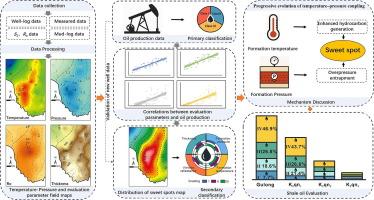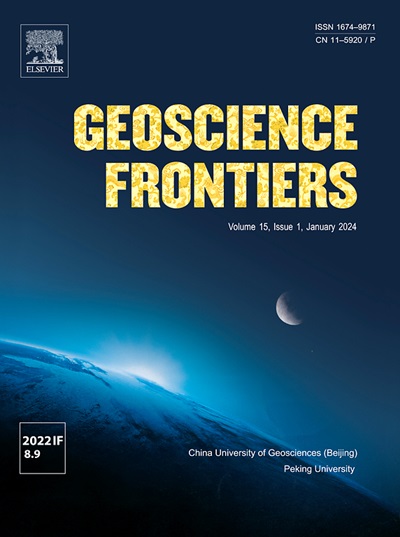东北重点地区现今温度和压力场:对非常规资源评价的启示
IF 8.9
1区 地球科学
Q1 GEOSCIENCES, MULTIDISCIPLINARY
引用次数: 0
摘要
含油气盆地内的温压场是控制油气生、运、聚的关键地质因素。本文以松辽盆地中央坳陷北部青山口组为研究对象。以地层温度压力为核心变量,利用当前油气场特征,建立多参数加权评价模型,对页岩油资源潜力进行评价。此外,探讨了地代史温压演化对页岩油成藏的控制机制,并进一步评价了该方法的适用性。结果表明:青山口组地温梯度从一段到三段依次减小(3.84°C/100 m, 2.93°C/100 m, 2.49°C/100 m);高温带在古龙凹陷分布广泛,古龙页岩平均温度超过95℃,平均约为115℃。青山口组超压呈西高东低趋势。古龙页岩超压带主要集中在齐家—古龙凹陷和三照凹陷,平均压力系数分别为1.52和1.36。Opc模型确定了ⅰ类和ⅱ类有利带,主要分布在古龙凹陷中部和南部以及三照凹陷中部和西南部,页岩油资源量估计分别为7.1×108 t和17.2×108 t。典型井的演化特征表明,高温促进了有机质成熟和轻质油的生成,提高了页岩油的流动性,而超压则抑制了油气的耗散,为采油提供了充分的动力。研究表明,现今的温度-压力场有效地反映了古热力和压力状态的演化趋势。该评价方法具有较强的适用性和可扩展性,为非常规油气资源勘探提供了新的技术框架和理论基础。本文章由计算机程序翻译,如有差异,请以英文原文为准。

Present-day temperature and pressure fields in key areas of Northeast China: Implications for unconventional resource evaluation
The temperature-pressure fields within hydrocarbon-bearing basins are key geological factors controlling hydrocarbon generation, migration, and accumulation. In this study, we focus on the Qingshankou Formation in the northern part of the central depression of the Songliao Basin, China. A multi-parameter weighted evaluation model was created using present temperature-pressure field characteristics, with formation temperature-pressure as core variables, to evaluate shale oil resource potential. In addition, we explored the control mechanisms of temperature-pressure evolution during geological history on shale oil accumulation and further assessed the applicability of the proposed method. Our results show that the geothermal gradient of the Qingshankou Formation decreases from Member 1 to Member 3 (3.84 °C/100 m, 2.93 °C/100 m, and 2.49 °C/100 m, respectively). High-temperature zones are widely distributed in the Gulong sag, with the average temperature of the Gulong shale exceeding 95 °C and reaching an average of approximately 115 °C. Overpressure in the Qingshankou Formation exhibits a west-high to east-low trend. The overpressure zones of the Gulong shale are mainly concentrated in the Qijia-Gulong and Sanzhao sag, with average pressure coefficients of 1.52 and 1.36, respectively. The Opc model identified Class I and II favorable zones, mainly located in the central and southern parts of the Gulong Sag, as well as the central and southwestern Sanzhao Sag, with estimated shale oil resources of tons and tons, respectively. Evolutionary profiles from representative wells indicate that elevated temperatures enhance organic matter maturation and light oil generation, improving shale oil mobility, while overpressure suppresses hydrocarbon dissipation and provides a sufficient driving force for oil production. This study demonstrates that present-day temperature-pressure fields effectively reflect the evolution trends of paleo-thermal and pressure regimes. The proposed evaluation method shows strong applicability and scalability, offering a new technical framework and theoretical foundation for the exploration of unconventional hydrocarbon resources.
求助全文
通过发布文献求助,成功后即可免费获取论文全文。
去求助
来源期刊

Geoscience frontiers
Earth and Planetary Sciences-General Earth and Planetary Sciences
CiteScore
17.80
自引率
3.40%
发文量
147
审稿时长
35 days
期刊介绍:
Geoscience Frontiers (GSF) is the Journal of China University of Geosciences (Beijing) and Peking University. It publishes peer-reviewed research articles and reviews in interdisciplinary fields of Earth and Planetary Sciences. GSF covers various research areas including petrology and geochemistry, lithospheric architecture and mantle dynamics, global tectonics, economic geology and fuel exploration, geophysics, stratigraphy and paleontology, environmental and engineering geology, astrogeology, and the nexus of resources-energy-emissions-climate under Sustainable Development Goals. The journal aims to bridge innovative, provocative, and challenging concepts and models in these fields, providing insights on correlations and evolution.
 求助内容:
求助内容: 应助结果提醒方式:
应助结果提醒方式:


